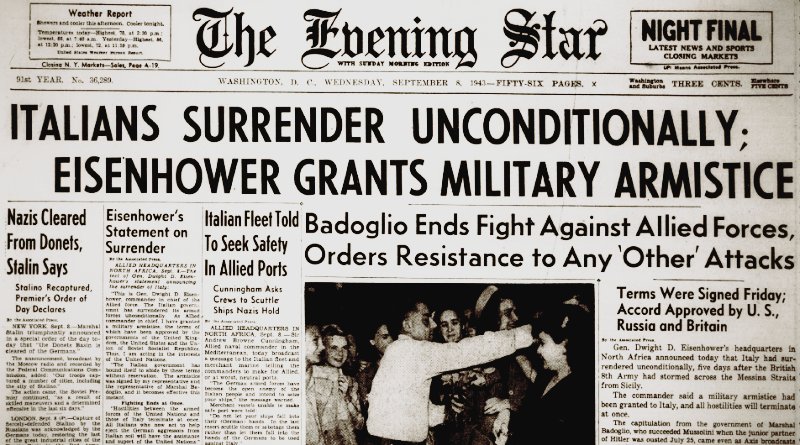World War II Chronicle: September 8, 1943
Click here for TODAY’S NEWSPAPER
Today Gen. Dwight Eisenhower announced that the Italians have surrendered unconditionally… A Marine home on leave following combat duty on Guadalcanal tells what kind of tricks Japanese soldiers play to kill unsuspecting Americans on page five… A U.S. artillery observer calls in fire on the town he used to live in on Sicily on page eight…
George Fielding Eliot column on page 10… Maj. Gen. Claire Chennault is pretty sure that the Japanese are flying an improved version of their “Zero” fighter (see page 13). This is the new-and-improved Mitsubishi A6M5 Type 0 Model 52… Sports on page 50
Roving Reporter by Ernie Pyle
SOMEWHERE IN SICILY — When the 45th Division went into service along the north coast of Sicily after several weeks of hard fighting, I moved on with the Third Division which took up the ax and drove the enemy on to Messina.
I am still doing engineering and it was on my very first day with the Third that we hit the most difficult and spectacular engineering job of the Sicilian campaign.
You’ve doubtless noticed Point Calava on your maps. It is a great stub of rock that sticks out into the sea, forming a high ridge running back into the interior. The coast highway is tunneled through this big rock, and on either side of the tunnel the road sticks out of the sheer rock wall like a shelf.
Our engineers figured the Germans would blow the tunnel entrance to seal it up. But they didn’t. They had even a better idea. They picked out a spot about 50 feet beyond the tunnel and blew a hole 150 feet long in the road shelf. They blew it so deeply and thoroughly that if you dropped a rock into it the rock would never stop rolling until it bounced into the sea a couple of hundred feet below.
We were beautifully bottlenecked. you couldn’t by-pass around the rock, for it dropped sheer into the sea. You couldn’t by-pass up over the mountain, for it would take weeks. You couldn’t fill the hole, for it would keep sliding off into the water.
All you could do was bridge it, and that was a hell of a job. But bridge it they did, and in only 24 hours.
When the first engineer officers went up to inspect the tunnel, I went with them. We had to leave the jeep at a blown bridge and walk the last four miles uphill. We went with an infantry battalion that was following the retreating Germans.
When we got there we found the tunnel floor mined. But each spot where they’d dug into the hard rock floor left its telltale mark so it was no job for the engineers to uncover and unscrew the detonators of scores of mines. Then we went on through to the vast hole beyond, and the engineering officers began making their calculations.
As we did so, the regiment of infantry crawled across the chasm, one man at a time. You could just barely make it on foot by holding on to the juttings and practically crawling.
Another regiment went up over the ridge and took out after the evacuating enemy with only what weapons and provision they could carry on their backs. Before another 24 hours, they’d be 20 miles ahead of us and in contact with the enemy, so getting this hole bridged and supplies and supporting guns to them was indeed a matter of life and death.
It was around 2 p.m. when we got there and in two hours the little platform of highway at the crater mouth resembled a littered street in front of a burning building. Air hoses covered the ground, serpentined over each other. Three big air compressors were parked side by side, their engines cutting off and on in that erratically deliberate manner of air compressors , and jack hammers clattered their nerve-shattering din.
Bulldozers came to clear off the stone-blocked highway at the crater edge. Trucks, with long trailers bearing railroad irons and huge timbers, came and unloaded. Steel cable was brought up. And kegs of spikes and all kinds of crowbars and sledges.
The thousands of vehicles of the division were halted some 10 miles back in order to keep the highway clear for the engineers. One platoon of men worked at a time in the hole. There was no use of throwing in with the whole company, for there was room for only so many.
At suppertime, hot rations were brought up by truck. The Third Division engineers go on K ration at noon but morning and evening they get hot food up to them, regardless of the job.
If you could see how they toil, you would know how important this hot food is. By dusk the work was in full swing and half the men were stripped to the waist.
The night air of the Mediterranean was tropical. The moon came out at twilight and extended our light for a little while. The moon was new and pale, and transient high-flying night clouds brushed it and scattered shadows down on us.
Then its frail light went out, and the blinding nightlong darkness settled over the insidious abyss. But the work never slowed or halted, throughout the night.
Evening star. (Washington, D.C.), 8 September 1943. Chronicling America: Historic American Newspapers. Lib. of Congress.
https://chroniclingamerica.loc.gov/lccn/sn83045462/1943-09-08/ed-1/
